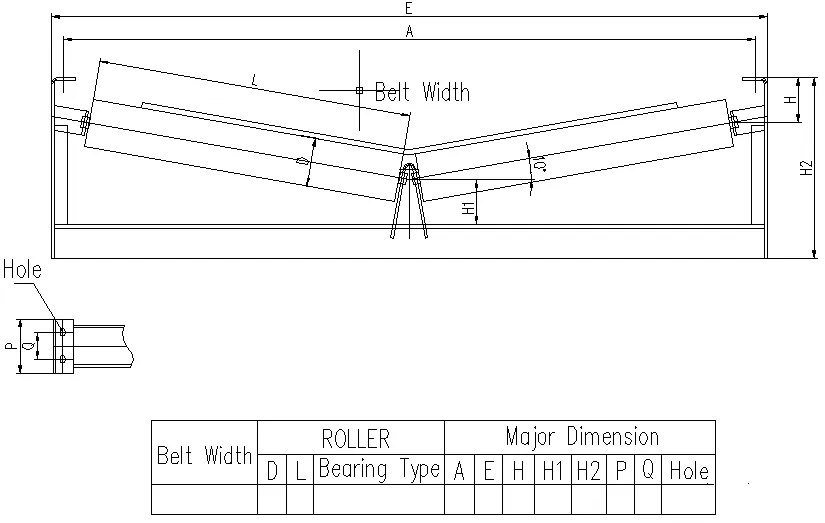Exploring Idler and Roller Mechanisms in Industrial Applications
Idler and Roller Essential Components in Machinery and Conveying Systems
In the realm of machinery and conveyor systems, idlers and rollers play a critical role in ensuring smooth operations. These components are integral to various industries, including manufacturing, mining, and logistics, where the efficient movement of materials is essential.
Understanding Idlers and Rollers
Idlers are components that do not propel the belt or material directly. Instead, they support and guide the belt, ensuring stability during its motion. Typically cylindrical in shape, idlers can be made from materials such as steel or plastic, and they come in various designs tailored to specific applications. Their primary role is to maintain tension and alignment in the conveyor belt, reducing the risk of wear and tear, and promoting a longer lifespan of the entire system.
Rollers, on the other hand, are designed to facilitate movement. They are often linked with powered sections of a conveyor system where the belt needs to be driven forward. Rollers can be powered, moving as the belt runs over them, or they can be non-powered, where they simply serve to support the belt without providing motion. The materials, design, and placement of rollers are crucial for optimizing the performance of a conveyor system.
Importance in Conveyor Systems
In a typical conveyor system, both idlers and rollers work in tandem to transport materials from one location to another. Their combined functionality helps to minimize friction between the belt and the supporting structures, leading to increased efficiency in material handling.
Idlers contribute significantly to the reduction of energy consumption in conveying systems. By providing proper support and maintaining the correct alignment of the belt, idlers ensure that the belt runs smoothly without excessive strain. This not only saves energy but also decreases the wear on both the belt and the drive components, ultimately enhancing the operational life of the entire system.
Rollers, especially powered ones, are critical in moving materials quickly and efficiently. They are often seen in industries where products need to be transported over long distances at high speeds. The design of rollers can vary; for example, some may have rubberized surfaces to provide better grip and reduce slipping, especially when handling heavier or more fragile loads.
idler and roller

Types of Idlers and Rollers
Idlers can be categorized into various types based on their application. For instance, troughing idlers are commonly used for bulk material handling as they form a V shape, allowing them to contain and guide materials effectively. Return idlers, on the other hand, are used on the underside of the conveyor to support the belt during its return journey.
Similarly, rollers come in different forms. Gravity rollers use gravity to move materials, while motorized rollers are driven by a motor to move items along the conveyor. Specialized rollers like impact rollers are designed to absorb shock when materials are loaded onto the conveyor, reducing damage and wear.
Innovations in Idler and Roller Technology
As industries continue to evolve, so does the technology behind idlers and rollers. Innovations focus on increasing durability, efficiency, and adaptability. For instance, advancements in materials science have led to the development of lightweight and corrosion-resistant materials, enhancing the performance of idlers and rollers even in harsh environments.
Furthermore, automation plays a significant role in modernizing these components. Smart rollers equipped with sensors provide real-time feedback on system performance, allowing for proactive maintenance and improved operational efficiency. This data-driven approach helps in optimizing the entire conveyor system, reducing downtime and operating costs.
Conclusion
Idlers and rollers may be small components in the grand scheme of machinery and conveyor systems, but their importance cannot be overstated. They are fundamental in ensuring the efficient and reliable transportation of materials across various industries. With ongoing innovations and a focus on efficiency, these components will continue to be central to the evolution of material handling solutions in the future.
-
Impact Roller for Belt Conveyor – Durable Solutions for IndustryNewsNov.24,2025
-
Rubber Conveyor Rollers – Quiet, Durable, Sealed BearingsNewsNov.24,2025
-
Industrial Conveyor Belt Rollers: Durable Solutions for Harsh EnvironmentsNewsNov.24,2025
-
Idler Rollers for Belt Conveyors | Durable, Low-Noise OEMNewsNov.24,2025
-
Durable Rubber Conveyor Belt Rollers for Industrial UseNewsNov.24,2025
-
Ceramic Lagging Conveyor Pulley – Anti-Slip, Wear-ResistantNewsNov.17,2025






























